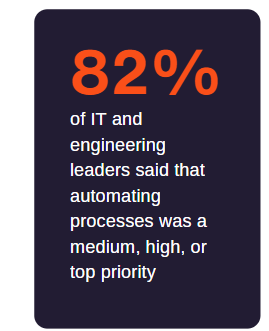Automation is increasingly becoming a priority for organizations. Companies are implementing automation in a variety of workflow settings. In a recent Salesforce survey, 82 percent of IT and engineering leaders said that automating processes was a medium, high, or top priority. Departments throughout the company are improving their ROI from automation, including human resources, operations, IT, marketing, customer service, and finance, the survey said. 
While automating most processes improves ROI,
it also improves the quality of the work. Automation
can improve consistency and eliminate human error.
In a 2020 Work Market survey, more than half of those surveyed indicated that automation eliminates human error.
Quality control automation, including quality control of translation, is no exception. Many organizations are using automation technology to improve the quality and efficiency of their translations. A translation quality management system presents many benefits
to ROI and linguistic quality.
Table of Contents:
- Automation Provides Cost Savings
- Automation Improves Decision-making
- Automation Improves Feedback
- Automation Can Assign Work
- Why Use an Automate Translation Quality Management System?
1. Automation Provides Cost Savings
Companies that use automation for translation quality assurance save money in much the same way that companies save money from implementing quality control automation in other areas. Before automation, employees typically monitor translation quality through Excel spreadsheets, recording quality scores, and delivering feedback to vendors. This monitoring often requires a significant amount of manual work, such as cutting and pasting.
Automation tools put an end to this mindless work. Many companies find that converting to an automated translation quality management system reduces their overhead by about 90 percent. Company employees are freed from mundane tasks and can focus on more strategic ones.
2. Automation Improves Decision-making
Linguistic quality assurance requires collecting and analyzing a significant amount of data. For example, translation QA gathers data on the accuracy of machine translation (MT). Data often includes highly detailed error annotation and a rating scale, also known as adequacy/fluency. Translation quality also collects data on the accuracy of human translators.
Manually gathering this data and analyzing it requires a considerable amount of time; in fact, many companies that collect and analyze information manually often make decisions based on data that is two to four weeks old. Automation of linguistic quality assurance keeps the data updated so that leaders can make decisions about 500 percent faster. Quality control managers can quickly observe trends, analyze changes, and plan timely interventions rather than waiting until projects are advanced.
Automated translation quality assurance tools automate tactics based on the leadership team's strategies. For example, companies might be willing to deal with rougher translations for in-house documents while wanting perfect translations for marketing content. Or, they may decide to focus on improving one key problem area in their translations rather than concentrating more broadly. Once the leadership team determines these priorities, the translation quality management system will automatically manage tasks to fit these priorities.
3. Automation Improves Feedback
Both humans and machines learn better with feedback, especially if the feedback is immediate. By automating the quality control of translations, human and machine translators can receive up to 1,000 percent more feedback. Automation also can automatically schedule quality evaluations for translators or translations based upon user-generated rules, such as budgets, strategic priorities, risk tolerance levels, and previous quality metrics. Translators and translations improve, yet vendor managers and quality managers can focus on other tasks, such as developing strategy or handling exceptions.
4. Automation Can Assign Work
A translation quality management system can automatically track the workload of quality evaluators. It also can keep track of each evaluator's training and experience. Then based upon the tracking and expertise information, it can assign work automatically.
5. Why Use an Automate Translation Quality Management System?
An automated translation quality management system automates the process of evaluating and improving human and machine translations based on your company's priorities. It can help you save money on overhead and allow your team to focus on less mundane tasks. It also can provide valuable feedback to your translators and organize your quality evaluation workflows.
If you need help in determining or automating your translation QA processes, Andovar can help. Andovar can help you with every aspect of your translations, including providing MT and human translations for documents, websites, apps, broadcast media, and games. We partner with ContentQuo, which makes the best translation quality management system, and many other leading technology providers.
Andovar is a niche, media-focused localization agency with a global presence. We help enterprise companies, games developers, eLearning, HR & training, technology (Software and Apps), MarCom, eCommerce, and media-focused organizations deliver media-rich global content to users, fans, clients, and employees across the globe. We are a one-stop solution with six offices across the globe to serve you 24/7. We work with more than 5,000 translators and 200 language pairs.
Every company has unique translation needs. Your company is no exception. Complete a contact form today to connect with an expert to talk about how to improve the quality of your translations.

For more tips and content for global growth, please visit our blog.











